Page 1028 of 4133
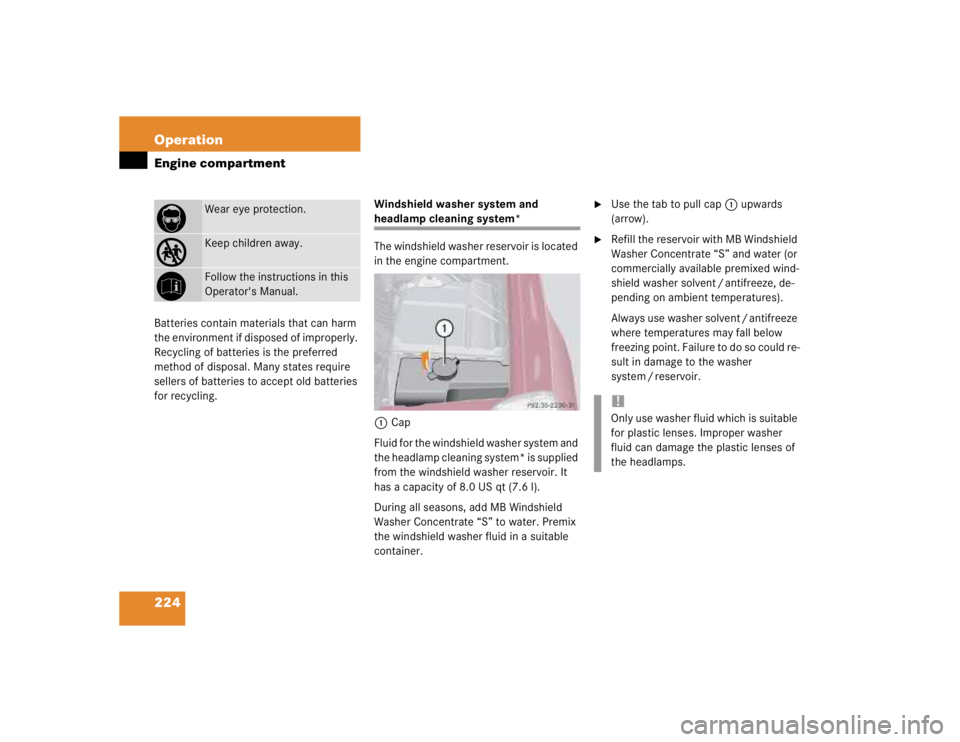
224 OperationEngine compartmentBatteries contain materials that can harm
the environment if disposed of improperly.
Recycling of batteries is the preferred
method of disposal. Many states require
sellers of batteries to accept old batteries
for recycling.Windshield washer system and
headlamp cleaning system*
The windshield washer reservoir is located
in the engine compartment.
1Cap
Fluid for the windshield washer system and
the headlamp cleaning system* is supplied
from the windshield washer reservoir. It
has a capacity of 8.0 US qt (7.6 l).
During all seasons, add MB Windshield
Washer Concentrate “S” to water. Premix
the windshield washer fluid in a suitable
container.
�
Use the tab to pull cap1 upwards
(arrow).
�
Refill the reservoir with MB Windshield
Washer Concentrate “S” and water (or
commercially available premixed wind-
shield washer solvent / antifreeze, de-
pending on ambient temperatures).
Always use washer solvent / antifreeze
where temperatures may fall below
freezing point. Failure to do so could re-
sult in damage to the washer
system / reservoir.
E
Wear eye protection.
C
Keep children away.
F
Follow the instructions in this
Operator's Manual.
!Only use washer fluid which is suitable
for plastic lenses. Improper washer
fluid can damage the plastic lenses of
the headlamps.
Page 1029 of 4133
225 Operation
Engine compartment
More information can be found in the
“Technical data” section (
�page 307).
Warning!
G
Washer solvent / antifreeze is highly flam-
mable. Do not spill washer
solvent / antifreeze on hot engine parts, be-
cause it may ignite and burn. You could be
seriously burned.
Page 1034 of 4133
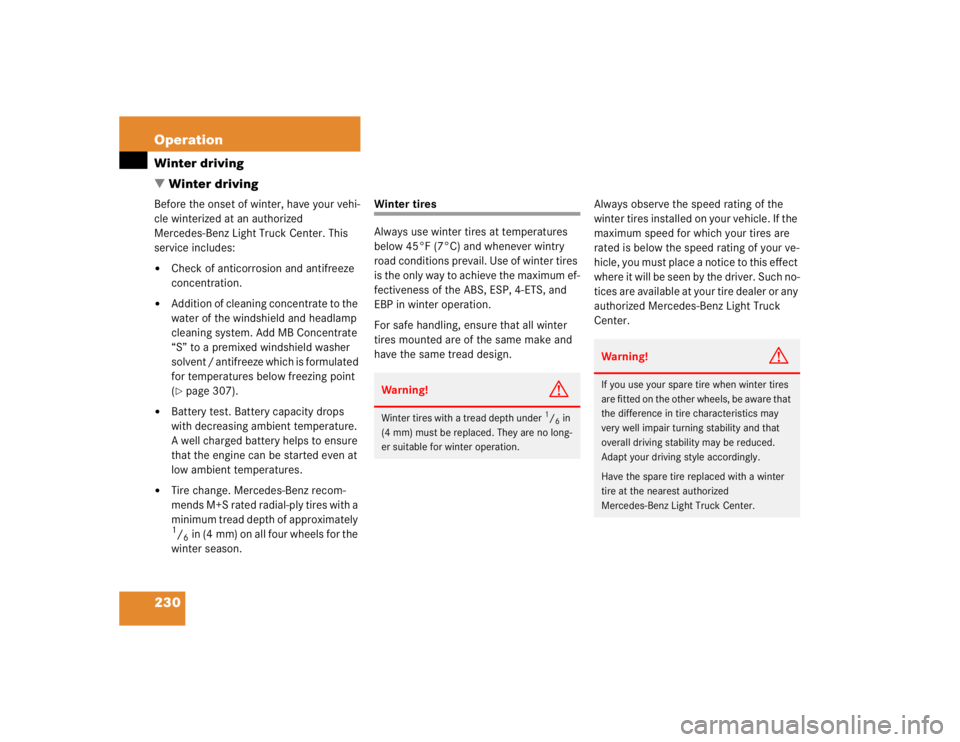
230 OperationWinter driving
�Winter drivingBefore the onset of winter, have your vehi-
cle winterized at an authorized
Mercedes-Benz Light Truck Center. This
service includes:�
Check of anticorrosion and antifreeze
concentration.
�
Addition of cleaning concentrate to the
water of the windshield and headlamp
cleaning system. Add MB Concentrate
“S” to a premixed windshield washer
solvent / antifreeze which is formulated
for temperatures below freezing point
(�page 307).
�
Battery test. Battery capacity drops
with decreasing ambient temperature.
A well charged battery helps to ensure
that the engine can be started even at
low ambient temperatures.
�
Tire change. Mercedes-Benz recom-
mends M+S rated radial-ply tires with a
minimum tread depth of approximately 1/6in (4 mm) on all four wheels for the
winter season.
Winter tires
Always use winter tires at temperatures
below 45°F (7°C) and whenever wintry
road conditions prevail. Use of winter tires
is the only way to achieve the maximum ef-
fectiveness of the ABS, ESP, 4-ETS, and
EBP in winter operation.
For safe handling, ensure that all winter
tires mounted are of the same make and
have the same tread design.Always observe the speed rating of the
winter tires installed on your vehicle. If the
maximum speed for which your tires are
rated is below the speed rating of your ve-
hicle, you must place a notice to this effect
where it will be seen by the driver. Such no-
tices are available at your tire dealer or any
authorized Mercedes-Benz Light Truck
Center.Warning!
G
Winter tires with a tread depth under
1/6in
(4 mm) must be replaced. They are no long-
er suitable for winter operation.
Warning!
G
If you use your spare tire when winter tires
are fitted on the other wheels, be aware that
the difference in tire characteristics may
very well impair turning stability and that
overall driving stability may be reduced.
Adapt your driving style accordingly.
Have the spare tire replaced with a winter
tire at the nearest authorized
Mercedes-Benz Light Truck Center.
Page 1035 of 4133
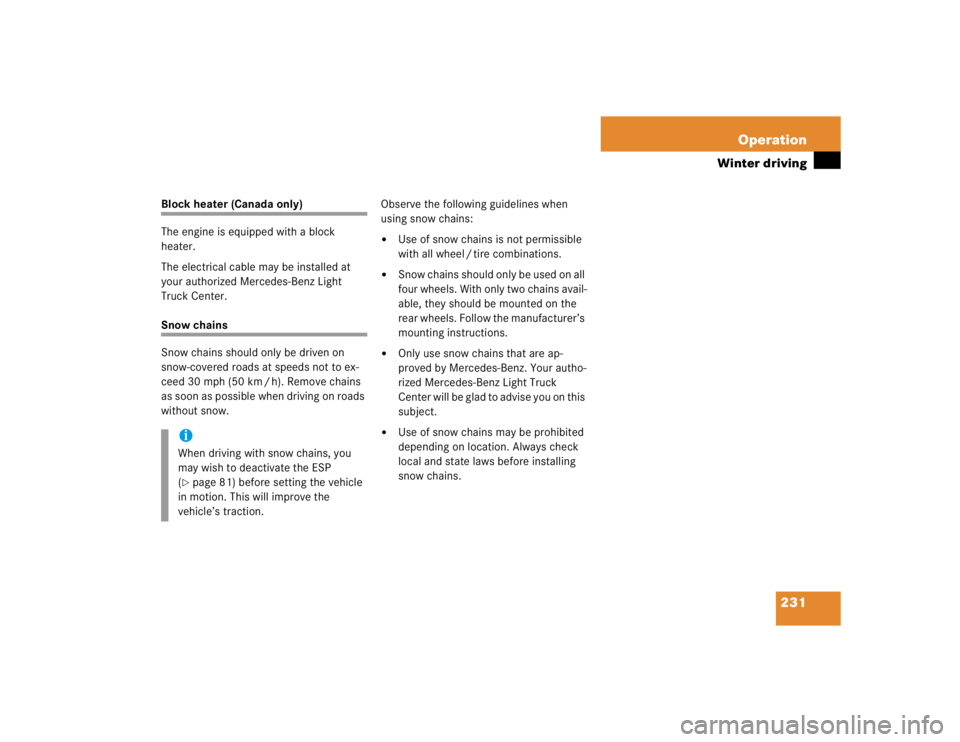
231 Operation
Winter driving
Block heater (Canada only)
The engine is equipped with a block
heater.
The electrical cable may be installed at
your authorized Mercedes-Benz Light
Truck Center.Snow chains
Snow chains should only be driven on
snow-covered roads at speeds not to ex-
ceed 30 mph (50 km / h). Remove chains
as soon as possible when driving on roads
without snow.Observe the following guidelines when
using snow chains:
�
Use of snow chains is not permissible
with all wheel / tire combinations.
�
Snow chains should only be used on all
four wheels. With only two chains avail-
able, they should be mounted on the
rear wheels. Follow the manufacturer’s
mounting instructions.
�
Only use snow chains that are ap-
proved by Mercedes-Benz. Your autho-
rized Mercedes-Benz Light Truck
Center will be glad to advise you on this
subject.
�
Use of snow chains may be prohibited
depending on location. Always check
local and state laws before installing
snow chains.
iWhen driving with snow chains, you
may wish to deactivate the ESP
(�page 81) before setting the vehicle
in motion. This will improve the
vehicle’s traction.
Page 1036 of 4133
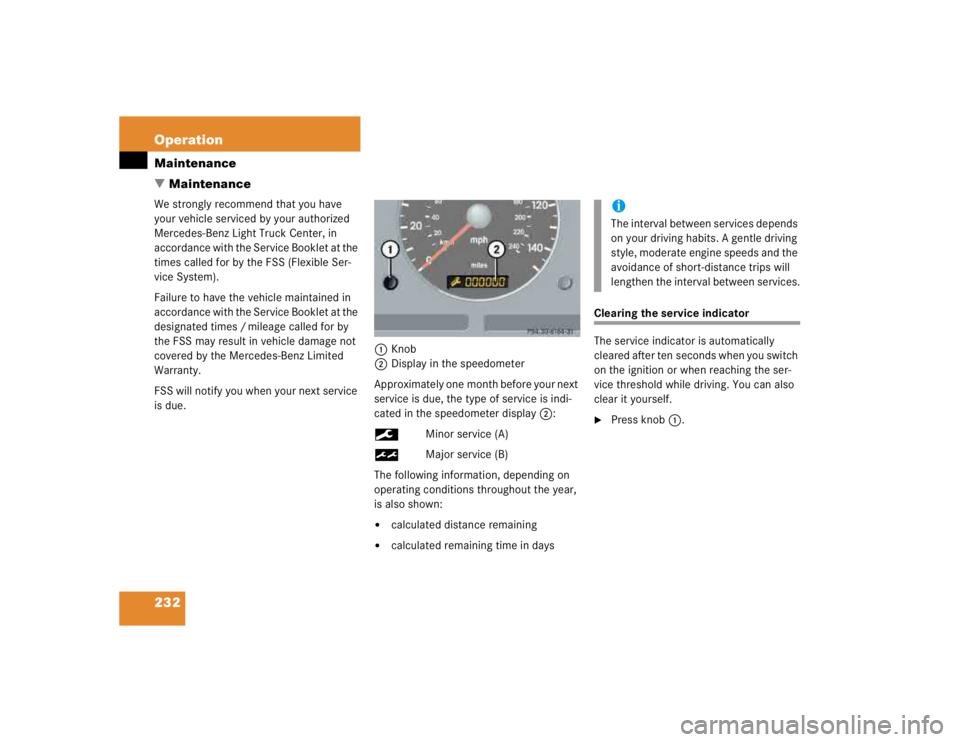
232 OperationMaintenance
�MaintenanceWe strongly recommend that you have
your vehicle serviced by your authorized
Mercedes-Benz Light Truck Center, in
accordance with the Service Booklet at the
times called for by the FSS (Flexible Ser-
vice System).
Failure to have the vehicle maintained in
accordance with the Service Booklet at the
designated times / mileage called for by
the FSS may result in vehicle damage not
covered by the Mercedes-Benz Limited
Warranty.
FSS will notify you when your next service
is due.1Knob
2Display in the speedometer
Approximately one month before your next
service is due, the type of service is indi-
cated in the speedometer display2:
9Minor service (A)
½Major service (B)
The following information, depending on
operating conditions throughout the year,
is also shown:
�
calculated distance remaining
�
calculated remaining time in days
Clearing the service indicator
The service indicator is automatically
cleared after ten seconds when you switch
on the ignition or when reaching the ser-
vice threshold while driving. You can also
clear it yourself.�
Press knob1.iThe interval between services depends
on your driving habits. A gentle driving
style, moderate engine speeds and the
avoidance of short-distance trips will
lengthen the interval between services.
Page 1037 of 4133
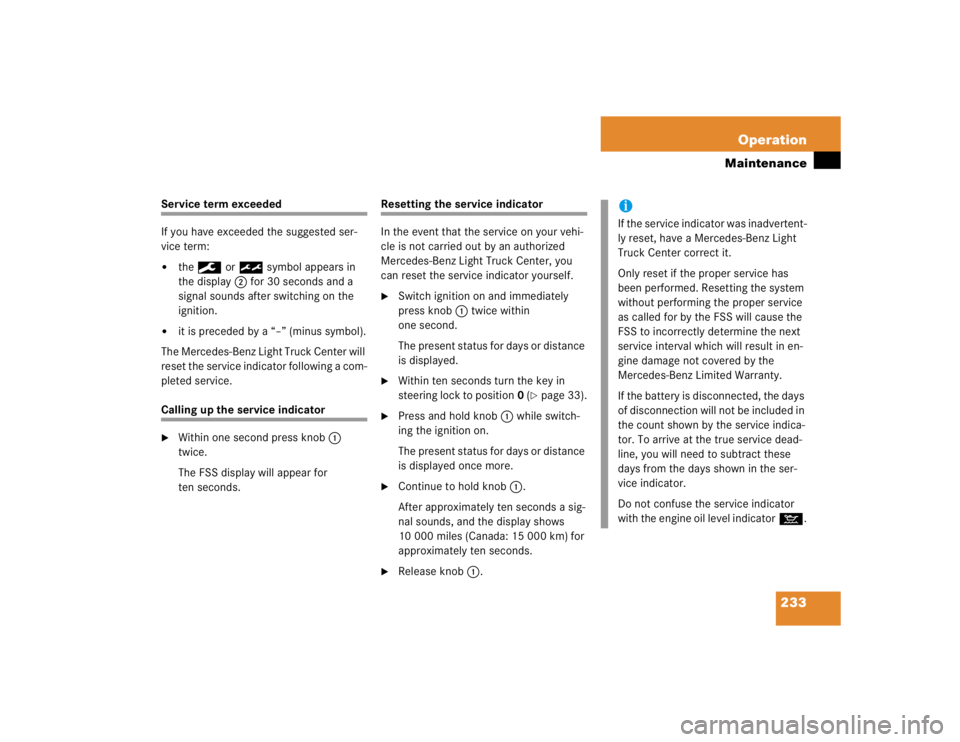
233 Operation
Maintenance
Service term exceeded
If you have exceeded the suggested ser-
vice term:�
the9 or ½symbol appears in
the display2 for 30 seconds and a
signal sounds after switching on the
ignition.
�
it is preceded by a “–” (minus symbol).
The Mercedes-Benz Light Truck Center will
reset the service indicator following a com-
pleted service.
Calling up the service indicator�
Within one second press knob1
twice.
The FSS display will appear for
ten seconds.
Resetting the service indicator
In the event that the service on your vehi-
cle is not carried out by an authorized
Mercedes-Benz Light Truck Center, you
can reset the service indicator yourself.�
Switch ignition on and immediately
press knob1 twice within
one second.
The present status for days or distance
is displayed.
�
Within ten seconds turn the key in
steering lock to position0 (
�page 33).
�
Press and hold knob1 while switch-
ing the ignition on.
The present status for days or distance
is displayed once more.
�
Continue to hold knob1.
After approximately ten seconds a sig-
nal sounds, and the display shows
10 000 miles (Canada: 15 000 km) for
approximately ten seconds.
�
Release knob1.
iIf the service indicator was inadvertent-
ly reset, have a Mercedes-Benz Light
Truck Center correct it.
Only reset if the proper service has
been performed. Resetting the system
without performing the proper service
as called for by the FSS will cause the
FSS to incorrectly determine the next
service interval which will result in en-
gine damage not covered by the
Mercedes-Benz Limited Warranty.
If the battery is disconnected, the days
of disconnection will not be included in
the count shown by the service indica-
tor. To arrive at the true service dead-
line, you will need to subtract these
days from the days shown in the ser-
vice indicator.
Do not confuse the service indicator
with the engine oil level indicator:.
Page 1040 of 4133

236 OperationVehicle careEngine cleaning
Prior to cleaning the engine compartment
make sure to protect electrical compo-
nents and connectors from the intrusion of
water and cleaning agents.
Corrosion protection, such as MB Anticor-
rosion Wax, should be applied to the en-
gine compartment after every engine
cleaning. Before applying, all control link-
age bushings and joints should be lubricat-
ed. The poly-V-belt and all pulleys should
be protected from any wax.
Vehicle washing
Do not use hot water or wash your vehicle
in direct sunlight. Use only a mild car wash
detergent, such as Mercedes-Benz
approved Car Shampoo.Thoroughly spray the vehicle with a dif-
fused jet of water. Direct only a very weak
spray towards the ventilation intake. Use
plenty of water and rinse the sponge and
chamois frequently.
Rinse with clear water and thoroughly dry
with a chamois. Do not allow cleaning
agents to dry on the finish.
Due to the width of the vehicle, fold in out-
side mirrors prior to running the vehicle
through an automatic car wash to prevent
damage to the mirrors.
In the winter, thoroughly remove all traces
of road salt as soon as possible.
When washing the underbody, do not for-
get to clean the inner sides of the wheels.Ornamental moldings
For regular cleaning and care of very dirty
chrome-plated parts, use a chrome clean-
er.
Headlamps, tail lamps, side markers,
turn signal lenses
Use a mild car wash detergent, such as
Mercedes-Benz approved Car Shampoo,
with plenty of water.
To prevent scratches, never apply strong
force and use only a soft, non-scratchy
cloth when cleaning the lenses. Do not at-
tempt to wipe dirty lenses with a dry cloth
or sponge.
Page 1048 of 4133
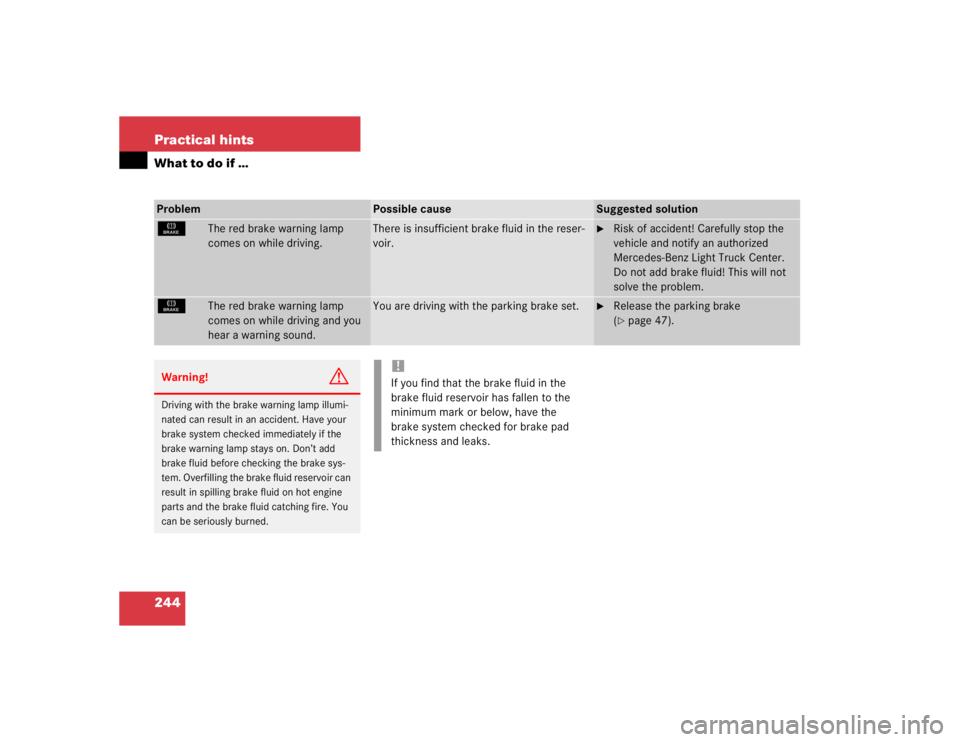
244 Practical hintsWhat to do if …Problem
Possible cause
Suggested solution
É
The red brake warning lamp
comes on while driving.
There is insufficient brake fluid in the reser-
voir.
�
Risk of accident! Carefully stop the
vehicle and notify an authorized
Mercedes-Benz Light Truck Center.
Do not add brake fluid! This will not
solve the problem.
É
The red brake warning lamp
comes on while driving and you
hear a warning sound.
You are driving with the parking brake set.
�
Release the parking brake
(�page 47).
Warning!
G
Driving with the brake warning lamp illumi-
nated can result in an accident. Have your
brake system checked immediately if the
brake warning lamp stays on. Don’t add
brake fluid before checking the brake sys-
tem. Overfilling the brake fluid reservoir can
result in spilling brake fluid on hot engine
parts and the brake fluid catching fire. You
can be seriously burned.
!If you find that the brake fluid in the
brake fluid reservoir has fallen to the
minimum mark or below, have the
brake system checked for brake pad
thickness and leaks.